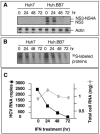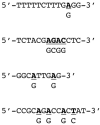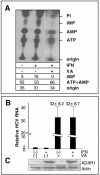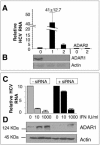New antiviral pathway that mediates hepatitis C virus replicon interferon sensitivity through ADAR1
- PMID: 15858013
- PMCID: PMC1091666
- DOI: 10.1128/JVI.79.10.6291-6298.2005
New antiviral pathway that mediates hepatitis C virus replicon interferon sensitivity through ADAR1
Abstract
While many clinical hepatitis C virus (HCV) infections are resistant to alpha interferon (IFN-alpha) therapy, subgenomic in vitro self-replicating HCV RNAs (HCV replicons) are characterized by marked IFN-alpha sensitivity. IFN-alpha treatment of replicon-containing cells results in a rapid loss of viral RNA via translation inhibition through double-stranded RNA-activated protein kinase (PKR) and also through a new pathway involving RNA editing by an adenosine deaminase that acts on double-stranded RNA (ADAR1). More than 200 genes are induced by IFN-alpha, and yet only a few are attributed with an antiviral role. We show that inhibition of both PKR and ADAR1 by the addition of adenovirus-associated RNA stimulates replicon expression and reduces the amount of inosine recovered from RNA in replicon cells. Small inhibitory RNA, specific for ADAR1, stimulated the replicon 40-fold, indicating that ADAR1 has a role in limiting replication of the viral RNA. This is the first report of ADAR's involvement in a potent antiviral pathway and its action to specifically eliminate HCV RNA through adenosine to inosine editing. These results may explain successful HCV replicon clearance by IFN-alpha in vitro and may provide a promising new therapeutic strategy for HCV as well as other viral infections.
Figures







Similar articles
-
Double-stranded RNA-activated protein kinase inhibits hepatitis C virus replication but may be not essential in interferon treatment.Liver Int. 2010 Feb;30(2):311-8. doi: 10.1111/j.1478-3231.2009.02144.x. Epub 2009 Oct 16. Liver Int. 2010. PMID: 19840259
-
Antiviral action of interferon-alpha against hepatitis C virus replicon and its modulation by interferon-gamma and interleukin-8.J Gastroenterol Hepatol. 2007 Aug;22(8):1278-85. doi: 10.1111/j.1440-1746.2007.04957.x. Epub 2007 Jun 12. J Gastroenterol Hepatol. 2007. PMID: 17565587
-
[Investigating the inhibitory effects of interferon-alpha on the replication of hepatitis C virus replicon].Zhonghua Yi Xue Za Zhi. 2005 Aug 3;85(29):2065-9. Zhonghua Yi Xue Za Zhi. 2005. PMID: 16313804 Chinese.
-
Hepatitis C virus molecular clones: from cDNA to infectious virus particles in cell culture.Curr Opin Microbiol. 2006 Aug;9(4):416-22. doi: 10.1016/j.mib.2006.06.012. Epub 2006 Jun 30. Curr Opin Microbiol. 2006. PMID: 16814596 Review.
-
In vitro replication models for the hepatitis C virus.J Viral Hepat. 2007 Jan;14(1):2-10. doi: 10.1111/j.1365-2893.2006.00807.x. J Viral Hepat. 2007. PMID: 17212638 Review.
Cited by
-
To translate, or not to translate: viral and host mRNA regulation by interferon-stimulated genes.Trends Cell Biol. 2015 Jun;25(6):320-9. doi: 10.1016/j.tcb.2015.02.001. Epub 2015 Mar 3. Trends Cell Biol. 2015. PMID: 25748385 Free PMC article. Review.
-
Genome-wide analysis of host mRNA translation during hepatitis C virus infection.J Virol. 2013 Jun;87(12):6668-77. doi: 10.1128/JVI.00538-13. Epub 2013 Apr 3. J Virol. 2013. PMID: 23552407 Free PMC article.
-
Neuralized E3 Ubiquitin Protein Ligase 3 Is an Inducible Antiviral Effector That Inhibits Hepatitis C Virus Assembly by Targeting Viral E1 Glycoprotein.J Virol. 2018 Oct 12;92(21):e01123-18. doi: 10.1128/JVI.01123-18. Print 2018 Nov 1. J Virol. 2018. PMID: 30111563 Free PMC article.
-
Identification of three interferon-inducible cellular enzymes that inhibit the replication of hepatitis C virus.J Virol. 2008 Feb;82(4):1665-78. doi: 10.1128/JVI.02113-07. Epub 2007 Dec 12. J Virol. 2008. PMID: 18077728 Free PMC article.
-
Human coding RNA editing is generally nonadaptive.Proc Natl Acad Sci U S A. 2014 Mar 11;111(10):3769-74. doi: 10.1073/pnas.1321745111. Epub 2014 Feb 24. Proc Natl Acad Sci U S A. 2014. PMID: 24567376 Free PMC article.
References
-
- Bass, B. L. 1997. RNA editing and hypermutation by adenosine deamination. Trends Biochem. Sci. 22:157-162. - PubMed
-
- Blight, K. J., A. A. Kolykhalov, and C. M. Rice. 2000. Efficient initiation of HCV RNA replication in cell culture. Science 290:1972-1974. - PubMed
-
- Foy, E., K. Li, C. Wang, R. Sumpter, Jr., M. Ikeda, S. M. Lemon, and M. J. Gale. 2003. Regulation of interferon regulatory factor-3 by the hepatitis C virus serine protease. Science 300:1145-1148. - PubMed
MeSH terms
Substances
LinkOut - more resources
Full Text Sources
Medical
Molecular Biology Databases
Research Materials

